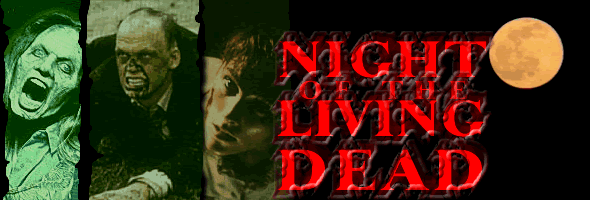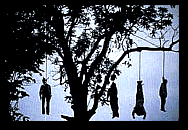
Color, 1990, 88 mins. Directed by Tom Savini
Starring Tony Todd, Patricia Tallman, Tom Towles, McKee Anderson, William Butler, Kate Finneran, Bill Moseley, Heather Mazur / Music by Paul McCullough / Written by George A. Romero / Cinematography by Frank Prinzi / Produced by John Russo and Russ Streiner
Format: DVD - Columbia (MSRP $19.95)
Letterboxed (1.85:1) (16x9 enhanced) / Dolby Digital 4.0
After a wayward zombie kills her brother, the withdrawn Barbara (Patricia Tallman, a familiar face to Bablyon 5 fans) flees through the countryside and winds up at an abandoned farmhouse. Other human survivors gather at the house to avoid the onslaught of flesh-hungry, walking dead: Ben (Candyman himself, Tony Todd), Harry Cooper (Tom Towles, a.k.a. Otis from Henry: Portrait of a Serial Killer), his wife Helen, and a young redneck couple including Leatherface's William Butler.
If this scenario sounds familiar, it should... at least until the last twenty minutes. While Savini includes some nice twists bound to surprise fans of the original throughout the film, starting with a nice jolt in the graveyard opener, he and writer Romero begin throwing some severe curveballs for the finale. Many critics felt betrayed by what seemed to be a radical departure from the jaded '60s nihilism of the original conclusion, but in an E.C. Comics-cum-Dawn of the Dead fashion, the new ending is very satisfying and perfectly in keeping with Romero's vision. Continuing its surprising dedication to the horror titles in its vaults, Columbia has presented Night of the Living Dead with some nice special features indicating more studio respect than one could have possibly guessed. Tom Savini provides a jam packed audio commentary filled with the usual Pittsburgh trivia and anecdotes about the difficulties of zombie wrangling. The Dead Walk, a very well-edited half hour featurette, also contains interviews with some of the principals, including Savini again, and includes some brief but juicy snippets of gory gunshots trimmed from the final cut to avoid an X rating. The film itself is surprisingly "sterile," to use Savini's term, with regards to graphic bloodshed, and this surprising approach also makes his film a worthwhile and unorthodox addition to American zombie cinema. Rounded off with the original trailer as well as one for William Castle's The Tingler(?), this one should leave horror fans drooling for more. The film itself looks better than ever, with the original orange tints (black and white on the laserdisc) restored to their original hellish glory over the end credits. The full frame edition of the film itself looks fine but, with the squarish compositions imposed by removing the mattes, the result suffers from a bland, made-for-video appearance that does the movie itself no favors. The anamorphic 1.85:1 presentation, on the other hand, restores a great deal of atmosphere and intensity to the proceedings, with a much tighter focus revealed during both the action scenes and dialogue interactions. Either one should suffice and deserves a look, but the comparisons back to back are quite surprising.
Remakes by their very definition are a very tricky business, and when it comes to remaking a classic horror film, the stakes can go even higher. Night of the Hunter, Invasion of the Body Snatchers, The Haunting, Black Sunday, and even Psycho have all come under the axe with varying results. So why would George Romero and the crew from the original 1968 Night of the Living Dead want to remake the undisputed daddy of all modern zombie films? Money, obviously; since the original was thought to be public domain, no one involved in the '68 production received their cut of the profits the film generated, so a color remake seemed like a good way to give everyone their share. Fortunately, the resulting film turned out much better than anyone had a right to expect. While there simply isn't a way to duplicate the horrific drive of the black and white original, the 1990 edition, capably helmed by effects master Tom Savini, stands as a respectable addition to Romero's "Dead" series and features enough new wrinkles of its own to merit attention from horror fans.
 Compare this to the "new" finale tacked on by John Russo for his 30th Anniversay edition of the '68 film, and there's no question who did a better job of capturing the insight and attitude of Romero's classic.
Compare this to the "new" finale tacked on by John Russo for his 30th Anniversay edition of the '68 film, and there's no question who did a better job of capturing the insight and attitude of Romero's classic.
